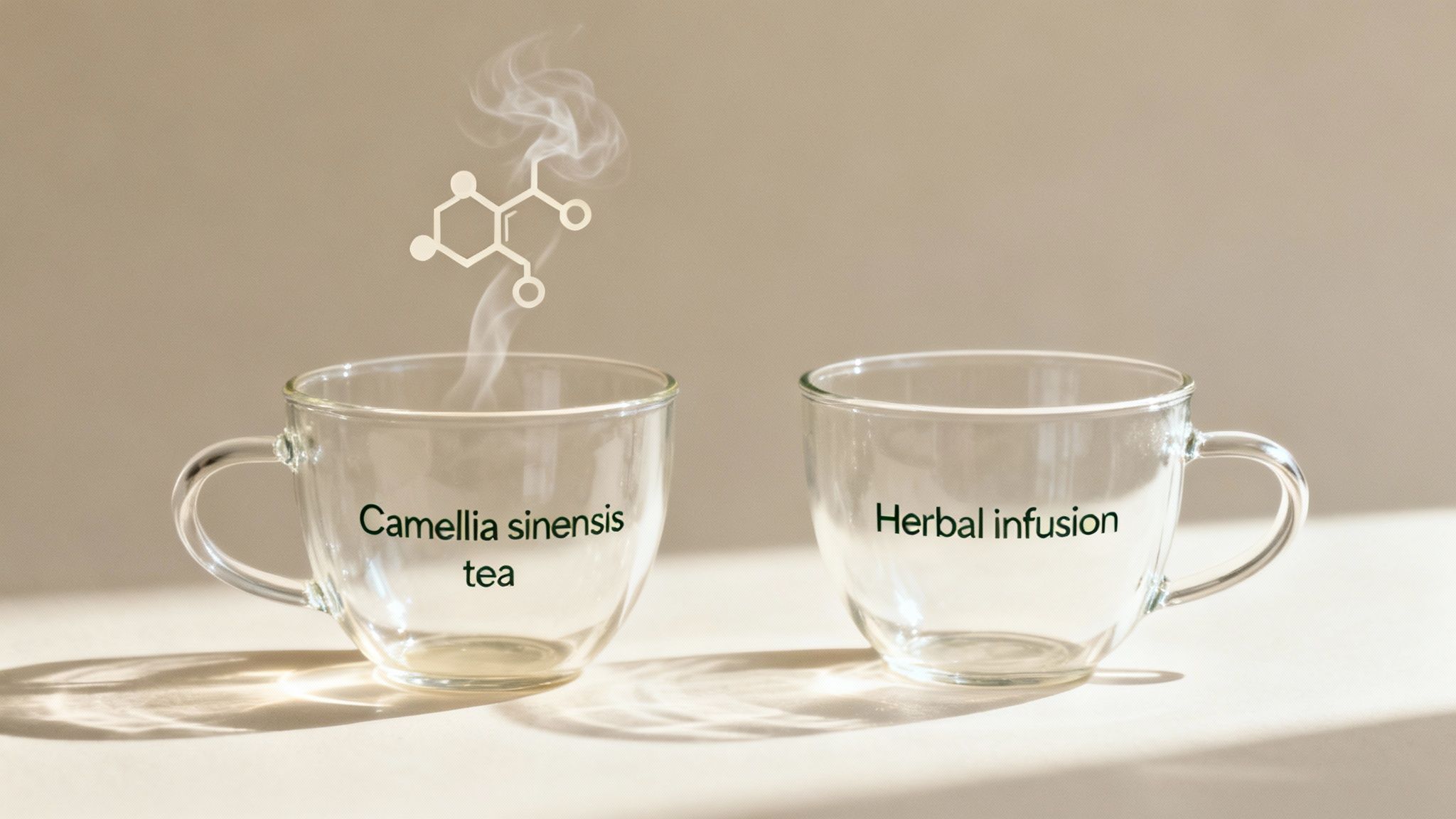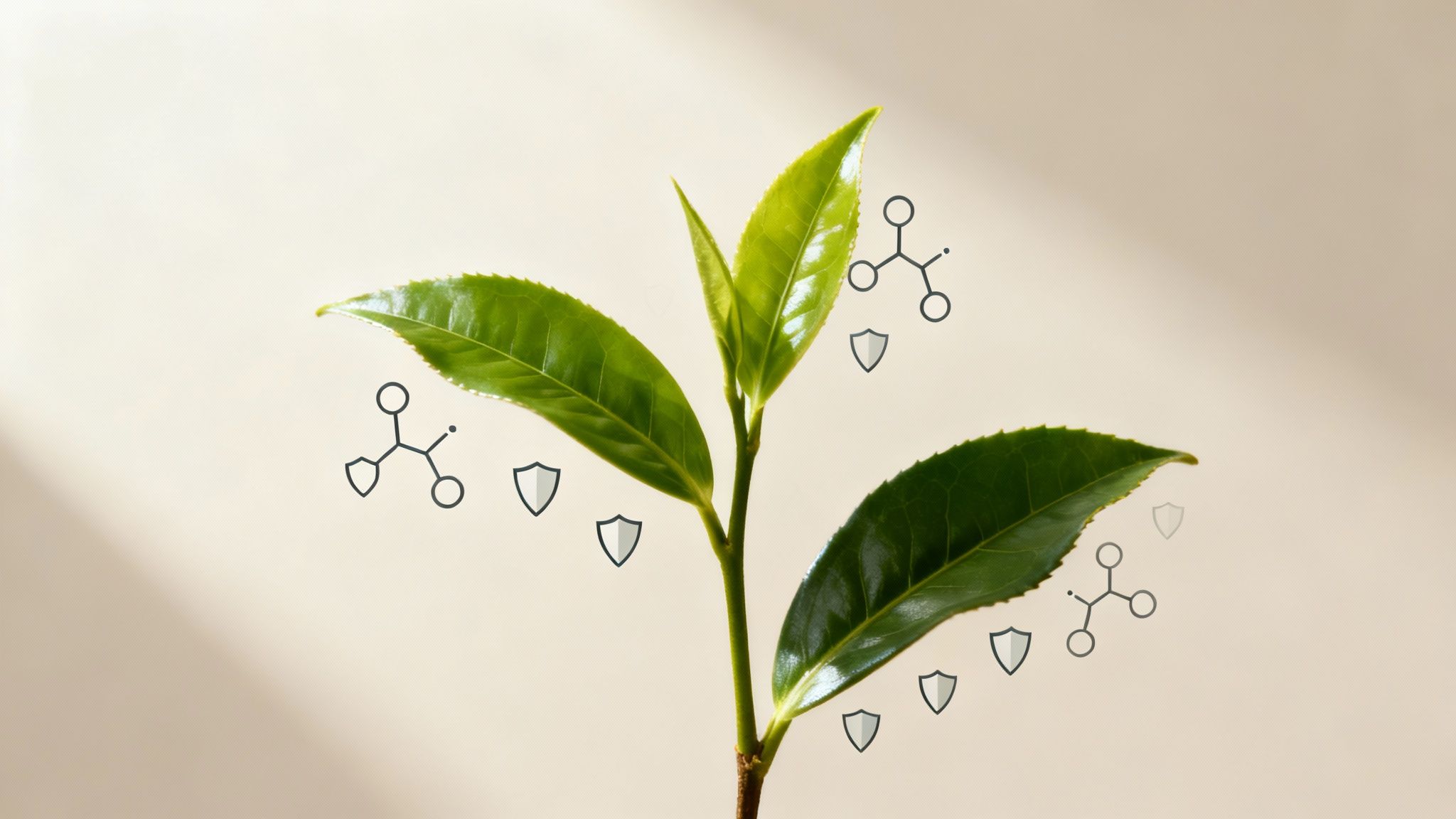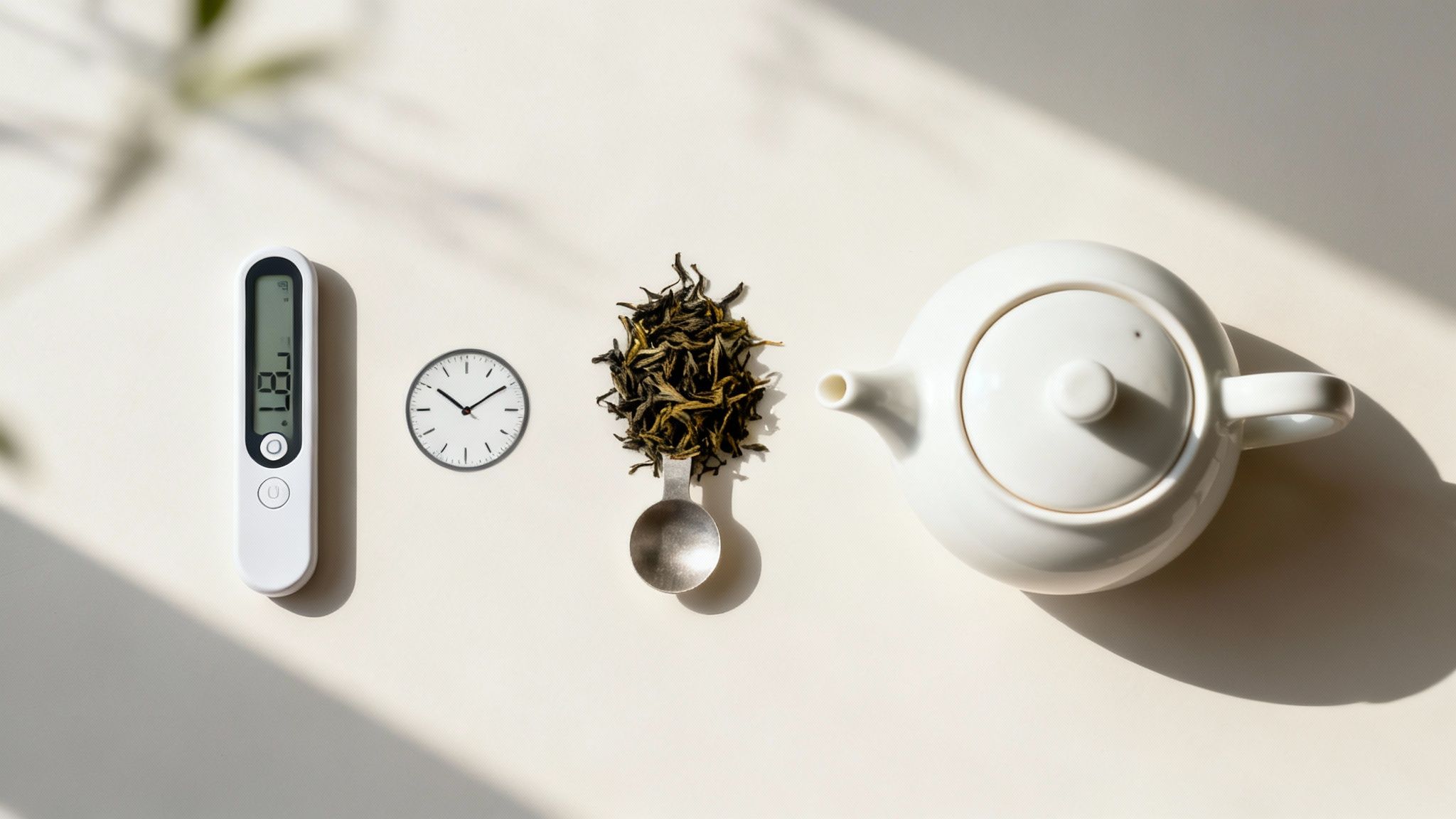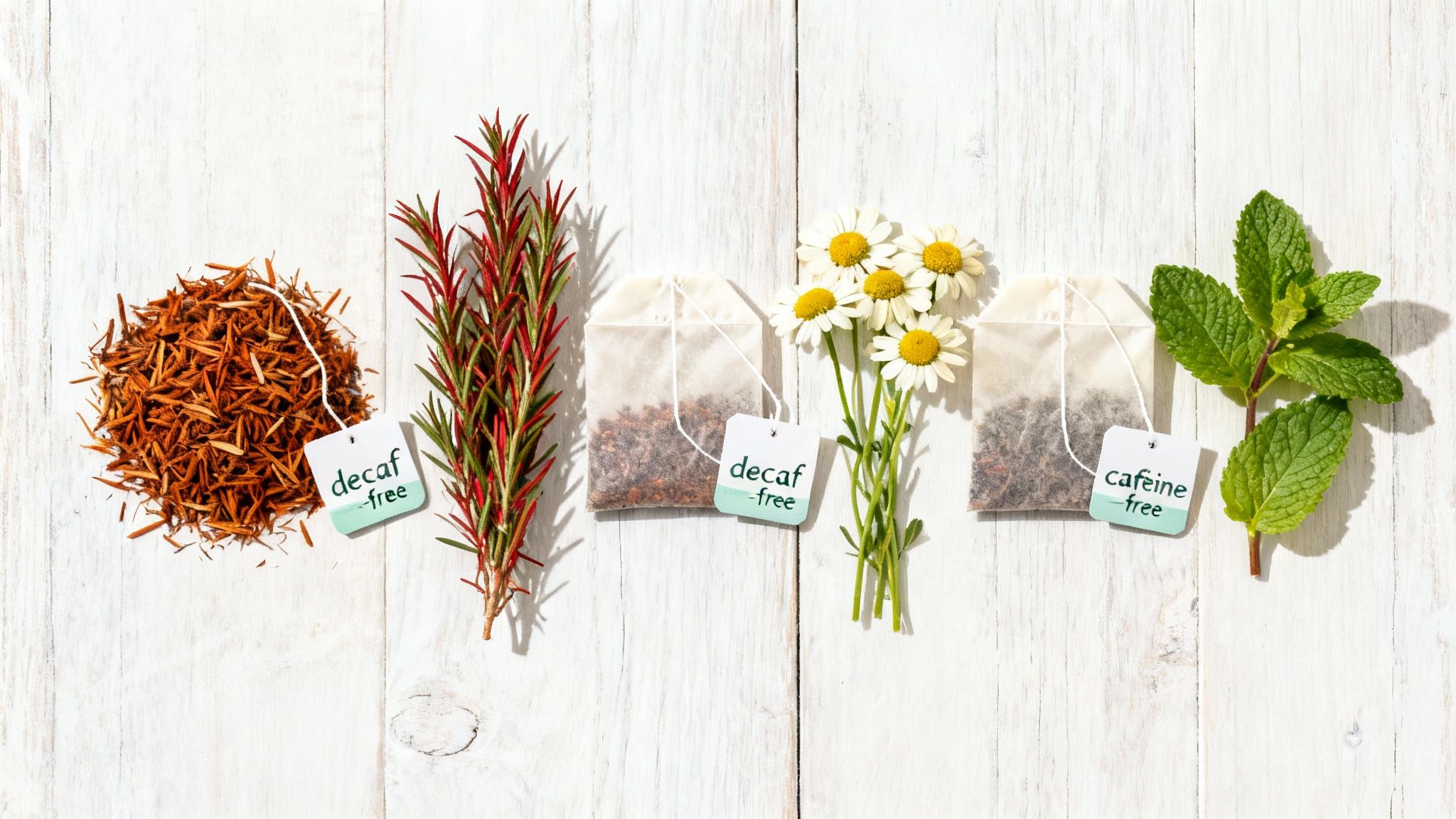Right, let’s get straight to the big question: does tea have caffeine? The short answer is yes, most of the teas you're familiar with absolutely do.
If you're drinking a proper tea—like black, green, oolong, or white—it comes from the leaves of a plant called Camellia sinensis. And this plant naturally produces caffeine. It’s as simple as that. Where people often get mixed up is with herbal infusions, but they’re a completely different kettle of fish.
Your Quick Guide to Caffeine in Tea

When we say "tea," we're often lumping two very different drinks under the same name. Getting your head around this is the first step to understanding what's actually in your cup. You've got 'true teas' on one side and herbal infusions on the other.
Think of all true teas as siblings. They all come from the exact same parent plant, Camellia sinensis. And just like siblings share certain traits, all these teas share one key component: caffeine. It’s part of their very nature. The fascinating differences in flavour and colour between black, green, or oolong tea all come down to what happens after the leaves are picked, not from a different plant.
True Teas vs Herbal Infusions
Herbal infusions, on the other hand, are a world apart. Things like chamomile, peppermint, or rooibos aren't made from the tea plant at all. They’re crafted from the leaves, flowers, or roots of other plants that simply don't produce caffeine.
This is why they are naturally 100% caffeine-free. It's the reason a mug of peppermint tea feels so calming before bed, while a morning cup of English Breakfast gives you that gentle, welcome lift.
To make it even clearer, here’s the breakdown:
- Contains Caffeine: Black, green, white, oolong, and matcha—anything from the Camellia sinensis plant.
- Naturally Caffeine-Free: Chamomile, rooibos, ginger, mint, and other fruit or herbal infusions.
In short, if it's a traditional tea, it’s got caffeine. If it’s a herbal brew, you can sip away knowing it’s almost certainly caffeine-free. Stick to that simple rule, and you'll always know what you're getting.
Caffeine at a Glance Your Quick Guide
To put it all into perspective, it helps to see how tea stacks up against other popular drinks. Here's a quick comparison of the typical caffeine content you'd find in a standard 240ml serving.
| Tea Type | Contains Caffeine? | Average Caffeine (mg) |
|---|---|---|
| Black Tea | Yes | 47 |
| Green Tea | Yes | 28 |
| White Tea | Yes | 30 |
| Oolong Tea | Yes | 37 |
| Herbal Tea | No | 0 |
| Coffee | Yes | 95 |
As you can see, even the strongest teas generally have less than half the caffeine of a regular coffee. It’s a gentle boost, not a jolt, which is precisely why so many of us love it.
Why Does Tea Have Caffeine in the First Place?

Ever stopped mid-sip and wondered where the gentle buzz in your daily cuppa actually comes from? It’s not something added during processing. In fact, it’s a completely natural part of the tea plant itself.
Every true tea—whether it's a bold black, a grassy green, or a delicate white—starts its life as a leaf on the Camellia sinensis plant. This one plant is the mother of thousands of tea varieties across the globe, and it produces caffeine for a very clever reason.
The Plant's Own Bodyguard
Think of caffeine as the plant’s personal security system. It’s a built-in defence mechanism, a natural pesticide designed to protect its most precious, tender parts from hungry insects.
When a bug decides to nibble on the young, nutrient-packed leaves and buds, it gets a bitter, toxic surprise. This jolt of caffeine is enough to deter most pests, encouraging them to find a less stimulating meal elsewhere.
This is also why the youngest leaves and buds—the most vulnerable parts of the plant—often pack the biggest caffeine punch. The plant channels its defensive chemistry to where it’s needed most. It's a neat little trick of nature that explains why some of the most prized teas, made from just the tips, can be surprisingly high in caffeine.
Caffeine isn't in tea just to give us a lift; its primary job in nature is to keep the plant safe. It's a fascinating glimpse into the sophisticated chemistry that has evolved in the plant world over millions of years.
Understanding this is key. The different ways we process tea leaves—like oxidation, which turns a green leaf into a black one—don't add any caffeine. They just change the flavour, colour, and other compounds of a leaf that already had caffeine from the moment it sprouted.
One Leaf, So Many Teas
So, is the caffeine content a result of how the tea is made? Not at all. It’s there right from the beginning. The journey from a freshly plucked leaf to the tea in your cup involves different steps, but the caffeine is determined by the plant's own biology.
Here’s a quick look at how that single leaf can become so many different types of tea:
- White Tea: The leaves are simply withered and dried, a minimal process to preserve their delicate nature.
- Green Tea: Leaves are heated soon after picking to stop oxidation, locking in that fresh, green character.
- Oolong Tea: The leaves are partially oxidised, creating a wonderfully complex flavour somewhere between green and black.
- Black Tea: Leaves are fully oxidised, a process that develops those deep, malty, and robust flavours we love.
Through it all, the caffeine that was in the fresh leaf remains in the final tea. The processing just unlocks a world of different aromas and flavours from the same remarkable plant. The caffeine was always part of the deal.
So, How Much Caffeine Are We Talking About?
When people ask, "does tea have caffeine?", the follow-up is almost always, "okay, but how much?". There's a popular myth that it's a simple sliding scale: white tea has the least, green is in the middle, and black tea has the most. While that's a decent starting point, the real story is far more nuanced and, frankly, much more interesting.
It's better to think of tea types as points on a spectrum rather than strict, separate boxes. The caffeine in your cuppa isn't just determined by whether the leaves are black or green. It's a complex dance involving the specific variety of the tea plant, the soil and climate it grew in, and—most crucially—what happens to the leaves after they're picked.
It All Comes Down to Oxidation
The main thing that separates black, green, oolong, and white teas is a process called oxidation. This is what happens when the enzymes inside the tea leaf are exposed to air, causing a reaction that transforms its flavour, colour, and chemical makeup.
- Black Tea: To make black tea, leaves are rolled and left to fully oxidise. This is what develops those deep, malty flavours we love and generally frees up more caffeine. You're typically looking at 40 to 70 mg per 240ml cup.
- Green Tea: Here, oxidation is stopped in its tracks by quickly heating the leaves. This locks in their fresh, grassy character and tends to result in less caffeine, usually around 20 to 45 mg.
- White Tea: Made from the youngest, most delicate buds and leaves, this tea is barely processed at all. It has a subtle, delicate flavour, but its caffeine content can be a bit of a wild card, ranging from as little as 6 mg to a surprising 55 mg.
Oolong tea, being only partially oxidised, sits comfortably in the middle, bridging the gap between its green and black cousins.
Comparing Caffeine in Your Favourite Teas
To make it a bit clearer, let's break down the typical caffeine levels you can expect from teas made from the Camellia sinensis plant.
| Tea Type | Typical Caffeine Range (mg per 240ml cup) | Key Characteristics |
|---|---|---|
| Black Tea | 40-70 mg | Fully oxidised. Robust, malty, and full-bodied. Think English Breakfast or Earl Grey. |
| Oolong Tea | 30-60 mg | Partially oxidised. A huge range of flavours, from light and floral to dark and roasted. |
| Green Tea | 20-45 mg | Unoxidised (heated to prevent it). Grassy, vegetal, and fresh notes. |
| White Tea | 6-55 mg | Least processed; unoxidised. Delicate, subtle, and often slightly sweet. |
| Matcha | 60-80 mg | Finely powdered green tea. Consuming the whole leaf delivers a potent, concentrated kick. |
As you can see, there's a lot of overlap. A strong white tea could easily have more caffeine than a weak green tea!
Matcha: The Exception to the Rule
And then there's matcha. Matcha is in a league of its own. It's a fine powder made from specially grown green tea leaves, and because you whisk the powder into water and drink the whole leaf, you're getting a much more powerful dose of everything—including caffeine. A single bowl of matcha can pack 60 to 80 mg of caffeine, often outdoing a strong cup of black tea.
As a rule of thumb, the amount of processing is a pretty good indicator. The more a tea leaf is oxidised (like black tea), the more of its caffeine is ready to be released when you add hot water.
This is a big deal here in the UK, where black tea is still king. The British tea market is a behemoth, valued at around 2.64 billion US dollars, and it's built on strong, caffeinated black teas from household names. With the average Brit knocking back about 265 litres of tea a year, that preference for a proper brew adds up.
Ultimately, the journey from a leaf on a bush to the brew in your cup is what shapes its final personality and caffeine hit. Getting to know the different types of tea and how they're made is the key to finding the perfect cup for any time of day, whether you need a gentle nudge or a proper boost.
How You Brew Changes Everything

It turns out you have far more say over the caffeine in your cup than you might think. The journey from dry leaf to finished brew involves a handful of variables you can easily tweak, each one directly influencing that final caffeine kick.
Think of yourself as the conductor of a tea orchestra. You control the key players: water temperature, how long you let it steep, and the amount of tea you use. Master these, and you can dial the caffeine up or down with surprising precision. It’s not just about picking a black or green tea; how you prepare it can make all the difference.
The Power of Steeping Time
Let’s start with the big one: steeping time. Caffeine is water-soluble, which is just a fancy way of saying it dissolves out of the tea leaves as soon as they hit hot water. The longer you let them sit, the more caffeine makes its way into your mug.
And the difference can be dramatic. Brewing a black tea bag for just one minute might only give you about 20 mg of caffeine—a very gentle lift. But let that same bag steep for a full five minutes, and you could easily be looking at 40-50 mg or more. The caffeine content can literally double.
There's a persistent myth that a quick 30-second 'rinse' of your tea leaves will wash away most of the caffeine. It's simply not true. Studies show that only about 20% of the caffeine is released in that first minute. A short steep definitely reduces caffeine, but it's a long way from eliminating it.
Temperature and Tea-to-Water Ratio
Hotter water is a much more powerful extractor. It pulls out everything—the delicate flavours, the healthy antioxidants, and of course, the caffeine—far more quickly and completely than cooler water does.
This is why using boiling water (around 100°C) for your black tea will give you a much bigger caffeine hit than using the cooler water (around 80°C) that we recommend for green tea.
The amount of tea you use is just as crucial. More leaves mean more potential caffeine. This is especially true if you’re a fan of loose leaf tea, where it's all too easy to be a bit generous with your scoops. Learning how to brew loose leaf tea properly puts you in complete command of your cup's strength.
And it’s worth remembering the crucial role of water quality in brewing as well, as it can subtly affect the entire extraction process.
Once you get a feel for these principles, you can customise every single cup. Need a strong boost to kickstart your day? Use a bit more black tea and steep it for five minutes in boiling water. Fancy a relaxing afternoon green tea? Use fewer leaves, cooler water, and a shorter brew time. You're in complete control.
UK Tea Culture and its Caffeine Impact
In the UK, tea isn't just a drink. It's woven into the very fabric of daily life—a comforting ritual, a social lubricant, and for millions, an absolute necessity. The humble ‘cuppa’ marks the start of the day, breaks up the afternoon, and punctuates just about every moment in between.
This deep-rooted love affair has a huge impact on the nation's caffeine consumption. For a massive chunk of the population, a strong cup of black tea is the main, and often preferred, source of their daily caffeine hit. We're not talking about a small habit; this is a national pastime on an epic scale.
The Scale of Britain's Tea Habit
The sheer amount of tea we get through is mind-boggling. According to the United Kingdom Tea and Infusions Association, Britons drink over 100 million cups of tea every single day. That adds up to a staggering 36 billion cups a year.
With a population of around 67.6 million, the average person is enjoying hundreds of cups of traditional, caffeinated tea annually. It's worth noting that this figure doesn't even include herbal infusions, which just goes to show how much we favour the proper, caffeinated stuff. You can dive deeper into the UK's tea-drinking habits over at Tasting Table.
So, the question "does tea have caffeine?" isn't just a scientific curiosity here. It's a practical reality that shapes the daily lives of an entire country.
The daily rhythm of British life is often set by the kettle’s whistle. From a builder’s brew on a cold morning to a delicate Earl Grey in a city office, the gentle buzz of caffeine from tea is what keeps the nation going.
The go-to choice is almost always a robust black tea, which naturally sits at the higher end of the caffeine scale. A standard British tea bag holds about 2 to 3 grams of dried leaves, which delivers a dependable 30 to 50 mg of caffeine per cup. When you start multiplying that by a few cups a day, it’s clear this cherished tradition is also a major caffeine delivery system, fuelling the energy and routines of people up and down the country.
Finding Your Perfect Low-Caffeine Cuppa

If you adore the comforting ritual of a warm cup of tea but want to cut back on caffeine, you're in luck. There are some truly wonderful options out there, but navigating the tea aisle can feel a bit confusing at first. The secret is knowing the difference between ‘decaffeinated’ and ‘caffeine-free’ brews.
Decaffeinated tea begins its life as the real deal—black or green tea from the Camellia sinensis plant. It then goes through a process to wash away most of the caffeine. It’s important to realise, though, that a tiny trace amount, usually around 2-5 mg, always lingers. This makes it a fantastic low-caffeine choice, but it’s not completely free of the stuff.
Exploring Naturally Caffeine-Free Herbal Infusions
For an experience that is guaranteed to be 100% caffeine-free, herbal infusions are your best friend. These aren't technically 'teas' at all, as they don't come from the tea plant. Instead, they’re beautiful blends of flowers, fruits, herbs, and spices that simply never contained any caffeine in the first place.
These infusions offer a whole world of flavours and benefits:
- Rooibos: Often called 'redbush tea', it has a naturally sweet, earthy flavour and is loaded with antioxidants.
- Chamomile: Famous for its gentle, calming properties, this delicate floral brew is perfect for winding down in the evening.
- Peppermint: A bright, refreshing and invigorating taste that's also wonderful for digestion.
The distinction is simple: 'decaf' means the caffeine has been removed, while 'caffeine-free' means it was never there to begin with. If you want a guaranteed zero-caffeine cup, always go for a herbal infusion.
This choice is becoming more and more relevant, especially when you look at shifting habits here in the UK. While 41% of British adults drink tea at least twice a day, it’s a ritual most popular among older generations. Only 11% of Gen Z drink tea daily, compared to 32% of Baby Boomers, showing a clear move towards less frequent tea drinking among younger people.
If you're looking for a relaxing brew to end your day, you might want to explore the 10 best bedtime teas. You can also discover a wonderful world of delicious non-caffeinated teas perfect for any time you fancy a brew without the buzz.
Your Tea & Caffeine Questions Answered
We’ve covered a fair bit of ground on the fascinating world of tea and its caffeine. Now, let's get straight to the questions we hear most often. Think of this as a quick-fire round to clear up any lingering curiosities.
Getting a handle on these details is what lets you truly master your own tea ritual, making sure every cup you brew is just right for you, no matter the time of day.
Does Adding Milk to Tea Reduce Caffeine?
It’s one of the great British tea debates, but the answer is a simple no. Splashing milk into your tea, or adding sugar or lemon for that matter, won't change the caffeine levels one bit.
These additions will definitely alter the flavour and feel of your brew, but the caffeine itself remains untouched. While the proteins in milk can bind with some of tea's other compounds (like tannins), they don't have any effect on the caffeine molecule itself. So, your cuppa will be just as stimulating.
Which Has More Caffeine: Tea or Coffee?
When you compare them cup for cup, coffee is the undisputed heavyweight. A typical 240ml mug of coffee packs a serious punch, usually containing between 95-200 mg of caffeine.
In the other corner, the same size mug of black tea offers a much more gentle lift, with around 40-70 mg. It's a common misconception that tea leaves are more caffeinated than coffee beans by weight—which is true! But the key difference is that we use far fewer leaves to brew a cup of tea, resulting in a much milder drink overall.
So, if you're after a powerful jolt to get you going, coffee is your best bet. For a more subtle, sustained focus, tea is the perfect partner.
Is It Okay to Drink Caffeinated Tea Before Bed?
For most of us, drinking a caffeinated brew like black or green tea just before hitting the pillow is probably not the best idea. The caffeine is a stimulant, after all, and it can make it harder to drift off and may reduce the quality of your sleep.
If you love the comforting ritual of a warm drink in the evening, you’re better off reaching for a naturally caffeine-free herbal infusion. Calming chamomile, earthy rooibos, or a refreshing peppermint tea are all wonderful choices to help you relax and unwind for the night, without any unwanted buzz.
Ready to explore the finest flavours without compromise? At Jeeves & Jericho, we source exceptional whole-leaf teas, from energising black teas to calming herbal infusions, ensuring every cup is a perfect experience. Discover our full collection today.


